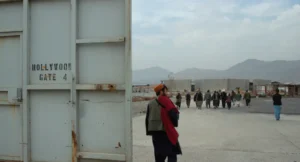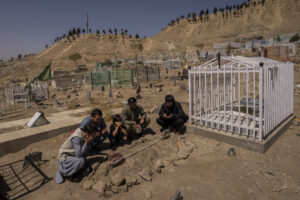Peace in Afghanistan Will Come at a Price
President Donald Trump has made a bid to end the 17-year war, but he fumbled on at least one major point. U.S. envoy Zalmay Khalilzad, left, discusses the war in Afghanistan with Pakistani Army Chief Gen. Qamar Javed Bajwa in Rawalpindi, Pakistan, in December. (Inter Services Public Relations via AP)
U.S. envoy Zalmay Khalilzad, left, discusses the war in Afghanistan with Pakistani Army Chief Gen. Qamar Javed Bajwa in Rawalpindi, Pakistan, in December. (Inter Services Public Relations via AP)
KARACHI, PAKISTAN — The U.S. is now trying desperately to pull its forces from Afghanistan. Seventeen years of war is long enough. The human toll has been heavy, with more than 2,200 American lives lost and 20,000 soldiers wounded. This figure doesn’t include the Afghan and Pakistani men, women and children who have suffered. Imperial powers still have to learn that it is easy to jump into another country that is weak and unstable—but to get out is a tougher job. And waging war in Afghanistan has never been a cakewalk for any outsider.
Moves are afoot there to work out a compromise, but the U.S. government has no understanding of how the present moves will change the diplomatic contours of Southwest Asia, the hub of America’s longest war in history. An American negotiator of Afghan origin, Zalmay Khalilzad, has been talking to the Taliban since August 2018.
Although the United States has been a major actor in this arc of instability and conflict, it is now turning to regional powers for help in pulling its chestnuts out of the fire. Donald Trump has done his utmost to revive the stalled peace process first launched in 2011 by the Obama administration. But the current president’s ham-handed approach has burdened him with problems of his own making.
Not realizing the sensitivities of the situation, Trump went on the warpath against Pakistan soon after he entered the White House in 2017. Having decided that Pakistan was the real culprit—“the wrong enemy” (to quote Richard Holbrooke, former U.S. special representative to Afghanistan and Pakistan) working against American interests in Afghanistan—Trump proceeded to adopt a mixed policy toward the Afghan conflict that has left him blowing hot and cold.
Initially, Trump’s offensive consisted of a war of words and tweets designed to sideline Pakistan by accusing that nation’s leaders of engaging in “deceit and lies.” Finally, however, he called a halt to the $1.3 billion worth of military aid that the U.S. had been supplying each year to Pakistan, a key actor in the region and a purported ally on which the Pentagon has relied for access to the theater of war in landlocked Afghanistan. Islamabad has been Washington’s key partner in the “war on terror” since the Russians invaded Afghanistan in 1979. Historically Pakistan has provided its northwestern neighbor with a vital overland transit route through the port city of Karachi.
Having sidelined a major ally, Trump went on to order his top diplomats to seek direct talks with the Taliban, aiming to jump-start negotiations to end the 17-year war in Afghanistan. It soon became evident that negotiating at the peace table is a different ballgame from fighting a war on the ground. It was then that the American president came to realize the potential role of Pakistan, the progenitor of the Taliban and the protector of the Haqqani network, in facilitating the peace process.
Trump has since had to eat his words and write to Pakistani Prime Minister Imran Khan to ask his government for help in advancing peace talks with the insurgents in Afghanistan. Trump even spoke of wanting to “have a great relationship with Pakistan.” While the latest statement from the White House says, “I look forward to meeting the folks from—and the new leadership in Pakistan, [and] we will be doing that in not-too-distant future,” Khan has been quick to seize credit for talks that have yet to make headway.
Three rounds of talks have already been held between the Taliban and Khalilzad with Pakistan, Saudi Arabia and the United Arab Emirates also in attendance. A deadlock looms large before the negotiators. The fourth round, scheduled in Riyadh, Saudi Arabia, later this month, seems threatened by foot-dragging. This is not surprising, as some preliminary issues have yet to be resolved. Who is to speak for the Afghans? At what stage should the real negotiations begin—before or after the withdrawal of foreign troops?
The Taliban are adamant that they are the legitimate representatives of the Afghan people, because it was their government that was toppled by the U.S. and its coalition allies in 2001. But would that scenario be acceptable to Washington? It would amount to the U.S. abandoning its own protege in Kabul and restoring the status quo after shedding so much blood.
The “talks before talks,” as the discussions are termed at this stage, are about looking for answers to difficult questions. Afghan President Ashraf Ghani—unlike his predecessor, Hamid Karzai—has acquiesced to the plan to let Khalilzad talk to the Taliban on his behalf. But would he agree to the U.S. negotiating substantial issues?
The Taliban want all foreign forces to be pulled out of Afghanistan before they talk to the present rulers in Kabul. For Ghani, the dilemma will be how to counter his rivals without American support. Moreover, Kabul’s relations with Islamabad have, historically, never been cordial. The baggage of disputes inherited from colonial times is too heavy to allow close ties to develop.
Besides, the situation on the ground in Afghanistan currently is not favorable for the Kabul administration. According to the Office of the Special Director General of Afghanistan Reconstruction, the Afghan government has control over 229 districts, while the Taliban control 59, and 119 are contested. This hardly represents a walkover for the Afghan government, especially without active American military backing.
Pakistan is viewed as a critical player, because it is believed to provide sanctuaries to insurgents in its territory. Moreover, its influence on the Taliban is immense, encouraging intransigence. Members of the Taliban believe that time is on their side and that if they hold on to this situation, victory will be theirs. Yet at times, the Taliban have been conciliatory within the same framework. They released an American soldier, Bowe Bergdahl, whom they had abducted and gave a political face to their dealings by opening a political office in Doha, Qatar, in 2014. In 2015, they entered briefly into direct talks with Kabul leaders. The insurgents even agreed to a cease-fire on the festival of Eid last year. On the other hand, the Taliban have unleashed terrible violence when they deem it necessary.
Trump will soon learn that negotiating peace with an enemy calls for more diplomacy and finesse than he has displayed.
When peace comes to Afghanistan it will come at a price—one that America and Pakistan will both pay. In the last two years, as Trump moved away from his predecessor’s South Asian policy, Pakistan moved rapidly toward forging new ties—including military relationships—with Russia and consolidating long-standing ties with China and other neighboring states (namely Iran, Saudi Arabia, the UAE, Turkey and Malaysia). The bailout packages obtained from some of them, along with China’s “One Belt, One Road” project, will help Pakistan tide over its economic crisis for the time being. But we do not know the secret commitments that have been made in return.
It must be remembered that Pakistan is a security state, and the fulcrum of power rests not in Islamabad but in Rawalpindi, where the military headquarters are located. The nation’s Afghan policy is controlled from there. It is thus not strange that Khalilzad had to call on General Qamar Bajwa, the chief of army staff, during his recent visit to Pakistan.
Because Islamabad has preferred not to reveal much, we will have to wait to learn what the future holds for Pakistan—and also the United States.
Your support is crucial…With an uncertain future and a new administration casting doubt on press freedoms, the danger is clear: The truth is at risk.
Now is the time to give. Your tax-deductible support allows us to dig deeper, delivering fearless investigative reporting and analysis that exposes what’s really happening — without compromise.
Stand with our courageous journalists. Donate today to protect a free press, uphold democracy and unearth untold stories.









You need to be a supporter to comment.
There are currently no responses to this article.
Be the first to respond.